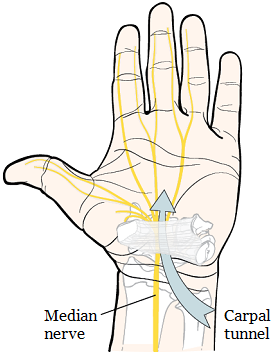
This information explains what carpal tunnel syndrome is. It also describes some of its common causes and symptoms, and how it can be treated.
About Carpal Tunnel Syndrome
Your carpal tunnel is a narrow tunnel in your wrist that protects your median nerve and other tissues (see Figure 1). Your median nerve is a nerve that runs from your forearm to your palm. It allows you to have feeling in your thumb and 3 middle fingers.
Carpal tunnel syndrome is when the tissues in your carpal tunnel swell and press on your median nerve. This can make your hand hurt or feel numb. In some people, the carpal tunnel is small, which makes them more likely to get carpal tunnel syndrome.
Causes of Carpal Tunnel Syndrome
Some things that can cause your carpal tunnel to swell are:
- Doing the same wrist movements over and over.
- Moving your wrist forcefully.
- Having a mass or growth (such as a tumor or cyst) in your wrist that presses on your median nerve.
- Getting a wrist injury (for example, if you dislocate, sprain, or break your wrist).
- Not having enough vitamin B6 in your diet.
- Using an aromatase inhibitor (uh-ROH-muh-tays in-HIH-bih-ter). This is a medication used to treat breast cancer. Using it may cause joint pain.
- Having a history of carpal tunnel syndrome in your family.
-
Having health problems, such as:
- Arthritis (painful swelling and stiffness of your joints).
- Kidney failure (when your kidneys cannot do their normal functions).
- Liver disease.
- Hypothyroidism (HY-poh-THY-roy-dih-zum). This is when your thyroid gland does not make enough hormones.
- Obesity (having a high, unhealthy amount of body fat).
- Amyloidosis (A-muh-loy-DOH-sis). This is a disease where proteins build up in your organs.
- Acromegaly (A-kroh-MEH-guh-lee). This is a disease that makes your bones grow much larger than normal.
Symptoms of Carpal Tunnel Syndrome
You may have just 1, some, or many symptoms (signs) of carpal tunnel syndrome. Your symptoms can change over time.
Symptoms often appear in your hands, wrists, and fingers. Common symptoms are:
- Pain.
- Burning.
- Numbness and tingling (slight stinging or poking), often in your thumb, index (pointer) finger, and middle finger.
- Weakness.
- Not being able to make a fist.
- Stiffness.
Diagnosing Carpal Tunnel Syndrome
To find out if you have carpal tunnel syndrome, your healthcare provider will:
- Review your health history.
- Give you a physical exam.
- Order tests that look at your muscles and nerves, as needed. These tests are called nerve conduction studies and electromyography (EMG).
Your healthcare provider may also order blood tests and X-rays. These are done to rule out other possible causes for your pain and swelling.
Treatment for Carpal Tunnel Syndrome
There are treatments that can help ease the symptoms of carpal tunnel syndrome. The amount of time it takes for symptoms to improve or go away is different for everyone.
The main goal of treatment is to ease the pressure on your median nerve, which will make your hand feel better. Another goal of treatment is to find out what is causing your carpal tunnel syndrome.
Types of treatment
The type of treatment you get depends on how long you have had your symptoms. It can also depend on how bad your symptoms are. Talk with your healthcare provider about what treatments are best for you.
Depending on your symptoms, your healthcare provider may suggest:
Treatments to prevent more pain and swelling
- Resting your wrist. Resting your wrist will help ease the pressure on your median nerve. It’s also helpful to stop or change any wrist movements that are making your symptoms worse.
- Wearing a wrist splint. A wrist splint is a support device that protects your hand and wrist and keeps them from moving. It keeps your wrist in a neutral position (not bent up or down) that does not cause strain. Wearing a wrist splint will help reduce the swelling that is pressing on your median nerve. Your healthcare provider will tell you how to wear your wrist splint.
Treatments to ease pain and swelling
-
Working with a physical therapist (PT) or occupational therapist (OT). Your healthcare provider may suggest that you work with a PT or OT who will:
- Give you suggestions on how to change habits that may be causing the strain.
- Fix your wrist splint so it fits the right way. They will also show you how to do your daily activities while wearing a splint.
- Show you how to move or hold your hand in a way that does not put pressure on your median nerve.
- Teach you exercises to make your hand and wrist stronger as you heal.
-
Taking nonsteroidal anti-inflammatory drugs (NSAIDs). Common NSAIDs are:
- Ibuprofen (Advil®, Motrin®)
- Naproxen (Aleve®, Naprosyn®)
- Celecoxib (Celebrex®)
- Meloxicam (Mobic®)
- Diclofenac (Voltaren®)
NSAIDs may cause side effects. Ask your healthcare provider if they are safe for you to take.
If these treatments do not work, your healthcare provider may suggest:
- Getting steroid injections (shots) into your carpal tunnel. Steroid shots are used if your pain does not go away after trying other treatments. These shots may help with the pain and swelling for a few weeks or months.
- Having surgery on your carpal tunnel. This can be done if other treatments have not worked. Surgery can help if you have a lot of pain and trouble moving your hand or wrist. The goal of surgery is to release pressure on your median nerve and reduce your pain.